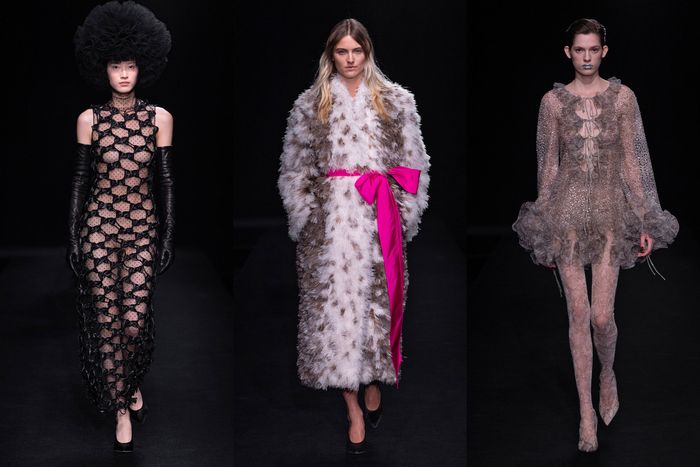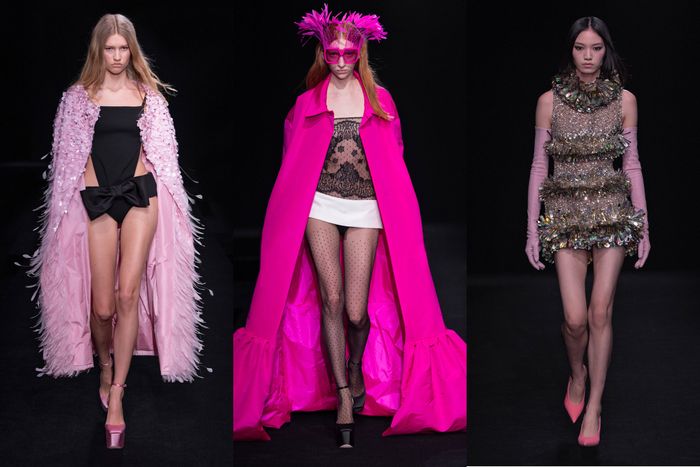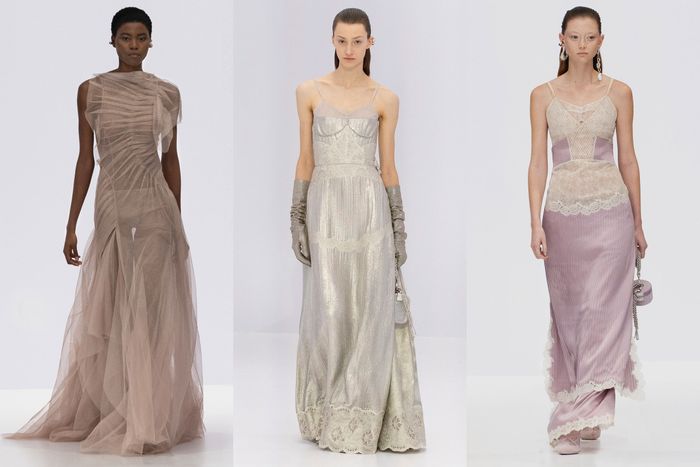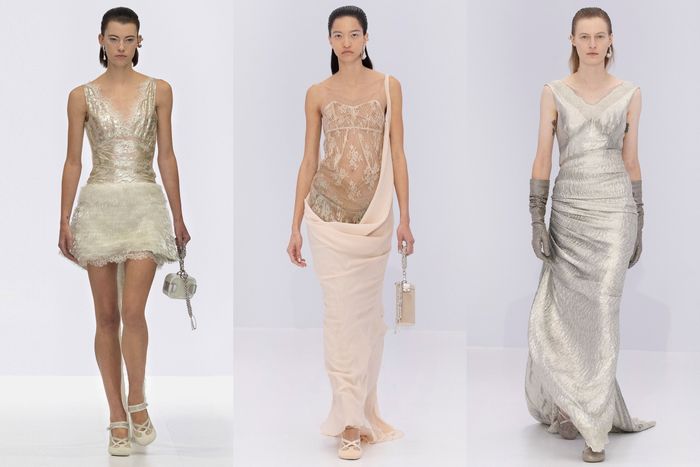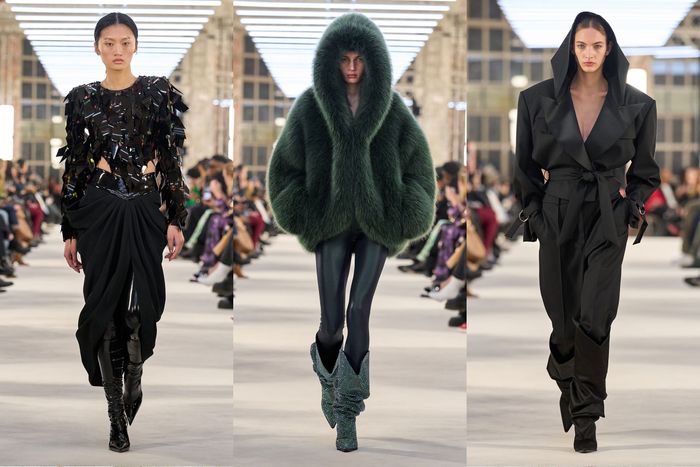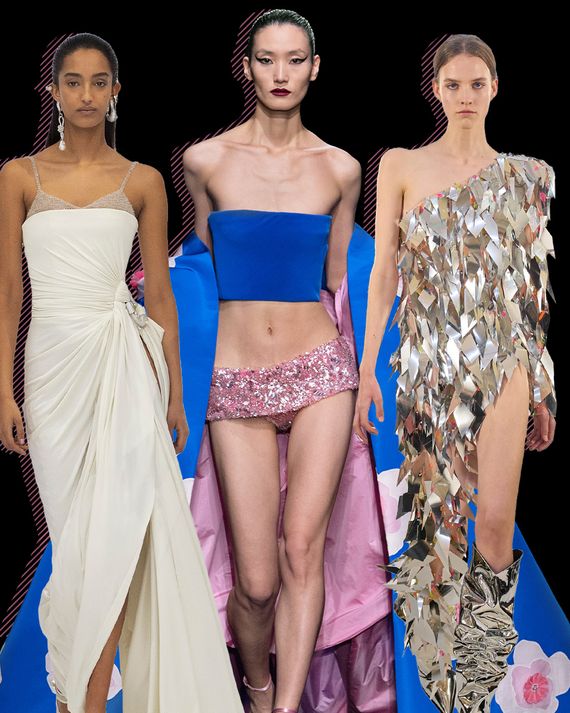
On the right bank of the Seine in Paris, under one of its great bridges, is a club with ancient stone walls and arches. It’s surprisingly spacious, not a dungeon, and that’s where Pierpaolo Piccioli held Valentino’s spring couture show on Wednesday night.
In the backstage moments before, the line of models (some 70 of them) snaked down a long corridor and into the dressing and makeup rooms. Meanwhile, white-coated seamstresses from Valentino’s Rome ateliers were fixing hems or lifting the train of a cerulean-blue satin cape appliquéd with big pink flowers or securing the bow on model Mona Tougaard’s ultra-mini skirt. Cheeks and nails were being touched up, and someone was trying to make the tiny hot-pink feathers on a model’s flapper-style headband stand up straight.
It was quite a party already, and the show hadn’t even started. I met a model wearing a giant Afro of black tulle. “No, it’s not leather,” Piccioli said, looking at her dress, a long shift of black loops and tiny bows creating a kind of chain-link effect over a sheer, dotted base. “Leather would be too heavy. This is actually a coated taffeta.”
The near-naked dress perfectly encapsulated Piccioli’s belief that haute couture — the practice of making clothes by hand for individual bodies — is only relevant if it talks to the moment, not to a beautiful past: “I know that young kids are really interested in couture, but I’m sure not because of the craft and tradition but because of boldness and fantasy.” Those heart-stopping moments have been few and far between this season. Too many clothes for clients. “I don’t want to care about customers, actually,” Piccioli said. “I want to do my job, and my job is to create a community of people to share.”
To that end, Piccioli conceived of his clothes in the egalitarian spirit of maximum, self-expressing, Instagrammable fun — in short, Le Club Couture. Apart from some lovely and generously cut wool coats and mohair wool shorts or trousers, no fabric, sequin, feather, rhinestone, flower, or scrap of lace was deployed toward “day clothes” in the usual sense.
And each look was unique — like a white gazar mini-tunic embroidered all over with three-dimensional white-lace flowers, a mini-shift coated with iridescent gold beads and finished with four bristly rows of golden trim, or a black one-piece swimsuit carved out deeply at the sides and finished with a black bow low in front and worn with a pink bathrobe coat embroidered with palettes and tiny feathers. I loved the fact that Piccioli’s show notes were organized by atelier — with credit going to the premieres, or chiefs, and the hands who made each look (sometimes as many as four people for one dress). And, of course, nearly all of the trippy fantasies were the result of the craft tradition. One rose-pink skirt was 64 meters of silk taffeta pleated and pleated — without cuts — until it was the size of a model’s hips.
On the runway, Piccioli’s Club Couture didn’t exactly manifest as a party. Something about the solemnity of a catwalk procession quite often kills the mood. That’s one thing about the supers of the past: They really knew how to gas up a spangled mini. Anyway, in the circus of the backstage, Piccioli made his point.
Kim Jones put on a fine show for Fendi focused on lingerie looks and draping, in the classical Roman sense, and powdery makeup shades with muted metallics. “I wanted this to be about dresses this season,” Jones explained, “because we sold a lot last season for weddings and parties. It’s really amazing when you meet the clients and the families. You learn a lot.” Some of the best work in the show were the laces, a flowing gown in a silver cloque with a mercury shimmer, and dresses with drapery over a simple transparent base and detailed bra.
But the collection suffered to an extent from not being challenging enough. I don’t mean that hideous word directional. Jones knows where he’s going. I mean only that he needed to be livelier about it — as he was in his fantastic Dior men’s show last week. He got his main inspiration from Yves Saint Laurent’s brief period at Dior in the late 1950s, then enveloped it in his affection for T. S. Eliot’s poem “The Waste Land” with readings from Robert Pattinson and Gwendoline Christie and a set by Baillie Walsh. The collection was chocked with new and strange things — as high fashion should be — and the use of Eliot’s modernist poem of regret was a daring and relevant stroke.
Julie de Libran, who spent much of her career at Prada and Louis Vuitton before opening her own small couture house, put on a buffet vegan lunch in her dream Paris apartment — with client friends modeling her easy and well-draped sequined dresses and a silk faille minidress in leopard spots with a short train. De Libran’s gift is for the elusively cool look that feels offhand and a little undone, ready to party without effort, as with a black slip dress with a neckline of ivory lace or a black taffeta bubble dress with a deep, open back.
I was impressed by Alexandre Vauthier’s collection. A protégé of Thierry Mugler and Jean Paul Gaultier, Vauthier knows how to make a statement on a runway using not just a riot of neon-colored tulle and shimmering, diamond-shaped palettes but also with strong, clear shapes — like his perfectly cut and oversize black blazers and a black silk-velvet dress that deftly follows the body’s outline and is just a pleasure to look at. The base of the dress was lined in tiny orange sequins to flash your entrance and, of course, your ta-tas.
More From the Couture Shows
- Ziwe and Lisa Rinna Brought RHOBH to Paris Fashion Week
- Seduction and Suiting at Couture Fashion Week
- At Couture Fashion Week, a Controversy



